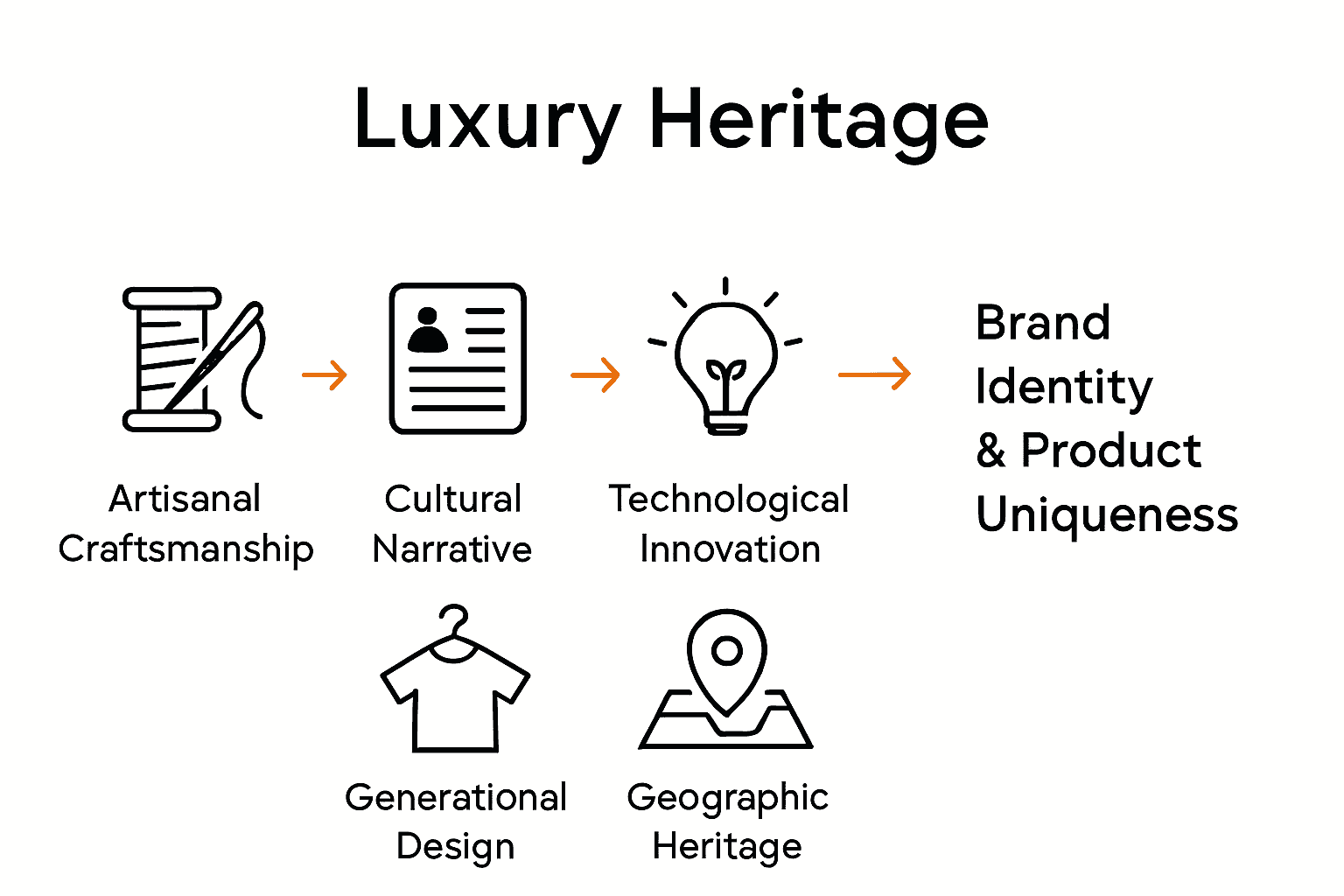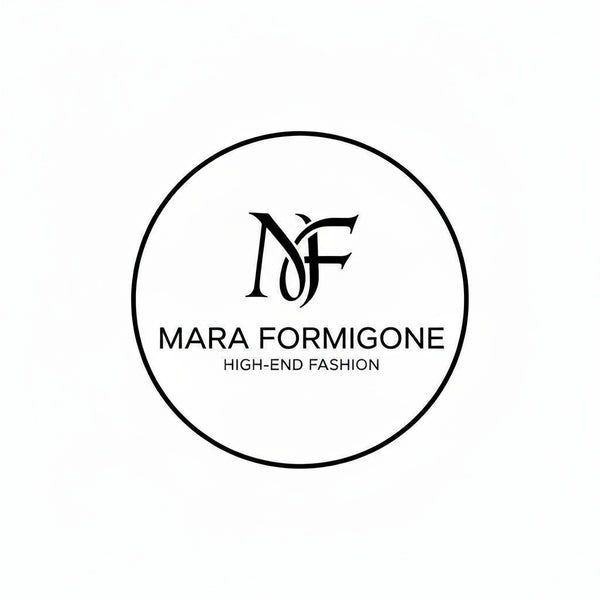Did you know that over 60 percent of luxury brands credit their success to deep-rooted heritage and traditional craftsmanship? What we wear carries far more meaning than just style or status. Fashion heritage is the thread connecting generations, shaping not only how designers create but also how people understand identity and culture. Discover how fashion heritage transforms clothing into vibrant stories and why it holds lasting value in today’s ever-evolving style world.
Table of Contents
- Defining Fashion Heritage And Core Concepts
- Types Of Fashion Heritage In Luxury Fashion
- Key Elements Shaping Brand Heritage
- How Fashion Heritage Influences Design And Value
- Risks And Missteps With Fashion Heritage
Key Takeaways
| Point | Details |
|---|---|
| Understanding Fashion Heritage | Fashion heritage connects clothing to cultural narratives, preserving traditional techniques and fostering emotional connections. |
| Types of Luxury Fashion Heritage | Luxury fashion embodies multiple heritage types, including artisanal craftsmanship and cultural narratives that enhance design value. |
| Influence on Design and Value | Heritage craftsmanship enriches luxury design, providing emotional resonance and justifying premium pricing through quality differentiation. |
| Risks of Cultural Missteps | Brands must carefully navigate cultural elements to avoid misappropriation and ensure authentic representation in design. |
Defining Fashion Heritage and Core Concepts
Fashion heritage represents more than just clothing and design. Cultural storytelling emerges through intricate textiles, traditional techniques, and emotional connections that transform garments from mere fabric into powerful narratives. According to UNESCO, fashion heritage encompasses the traditional craftsmanship and cultural values embedded in clothing, textiles, and accessories, reflecting aesthetic innovation and global cultural representation.
At its core, fashion heritage bridges generations through design. It transforms clothing from functional coverings into living archives that communicate identity, social dynamics, and artistic expression. ArchEdu highlights that this process involves preserving traditional craftsmanship and cultural narratives, enabling designers to create pieces that forge deep emotional connections with audiences.
The fundamental elements of fashion heritage include:
- Preservation of traditional crafting techniques
- Storytelling through textile design
- Maintaining cultural authenticity
- Celebrating generational artistic skills
- Translating historical aesthetic practices into contemporary fashion
Understanding fashion heritage requires recognizing that every stitch, pattern, and textile choice carries profound cultural significance. Designers who respect and integrate these historical foundations can create collections that transcend temporary trends, instead offering timeless expressions of human creativity and cultural identity.
Types of Fashion Heritage in Luxury Fashion
Luxury fashion heritage is a multifaceted concept that transcends simple design approaches, encompassing intricate layers of cultural and artistic expression. According to IED, heritage in luxury fashion manifests through traditional craft methods like hand sewing and fine carving, which play a strategic role in contemporary design by blending tradition with innovation.
Craft-based heritage represents one of the most profound manifestations of fashion legacy. This type of heritage focuses on preserving specialized techniques passed down through generations, where artisan skills become the cornerstone of luxury design. ArchEdu emphasizes that luxury fashion incorporates various heritage types, including traditional craftsmanship, cultural narratives, and fusion fashion that blends classic styles with modern designs.
The primary types of fashion heritage in luxury design include:
Here’s a comparison of the main types of fashion heritage in luxury design:
| Heritage Type | Key Characteristics | Example Elements |
|---|---|---|
| Artisanal Craftsmanship | Intricate handwork Specialized skills |
Embroidery Hand-stitched garments |
| Cultural Narrative Heritage | Tells cultural stories Symbolic designs |
Traditional motifs Ethnic patterns |
| Technological Heritage | Combines tradition and technology | Laser-cut textiles Digital weaving |
| Generational Design Heritage | Inherited, reimagined aesthetics over time | Vintage silhouettes Classic styles |
| Geographic Heritage | Region-specific techniques and materials | Scottish tweed Japanese indigo |
- Artisanal Craftsmanship: Techniques involving intricate handwork and specialized skills
- Cultural Narrative Heritage: Designs representing specific cultural identities and stories
- Technological Heritage: Innovative techniques that merge traditional methods with contemporary technologies
- Generational Design Heritage: Aesthetic approaches inherited and reinterpreted across different design periods
- Geographic Heritage: Design elements unique to specific regional traditions
Understanding these heritage types reveals how luxury fashion transforms clothing from mere garments into complex cultural artifacts. Each design choice becomes a deliberate conversation between past traditions and contemporary aesthetic sensibilities, creating collections that are simultaneously timeless and innovative.

Key Elements Shaping Brand Heritage
Brand heritage is a complex tapestry of strategic elements that transform fashion labels from mere clothing producers into legendary cultural institutions. According to Dr Press, brand heritage is fundamentally shaped by critical components such as a compelling origin story, exceptional quality, traditional craftsmanship, and a distinct sense of uniqueness that contributes to the brand’s luxurious image and drives consumer loyalty.
The foundational narrative of a fashion brand plays a crucial role in establishing its heritage. Diva Portal emphasizes that brand heritage is deeply rooted in the personal style and influential vision of its founders, highlighting the importance of maintaining core values while simultaneously adapting to evolving market dynamics. This delicate balance between preserving tradition and embracing innovation becomes the hallmark of truly iconic fashion brands.
Key elements that consistently shape and define brand heritage include:
- Authentic Storytelling: Creating a compelling historical narrative
- Consistent Design Philosophy: Maintaining a recognizable aesthetic language
- Craftsmanship Excellence: Preserving high-quality production techniques
- Cultural Relevance: Connecting with broader social and artistic movements
- Generational Knowledge Transfer: Passing down specialized skills and design wisdom
Ultimately, brand heritage transcends mere product creation. It represents a sophisticated dialogue between historical roots and contemporary expression, where each design becomes a deliberate statement of cultural continuity and artistic evolution. Successful luxury fashion brands understand that their heritage is not static but a living, breathing narrative that continually reinterprets tradition through modern creative perspectives.
How Fashion Heritage Influences Design and Value
Design transformation in luxury fashion is deeply rooted in the profound impact of heritage craftsmanship. According to IED, fashion heritage fundamentally influences design by integrating traditional craft methods, which significantly enhances the uniqueness and quality of products, thereby increasing their inherent value in the luxury market.
Beyond mere aesthetic considerations, heritage storytelling becomes a critical mechanism for creating emotional resonance with consumers. ArchEdu highlights that incorporating fashion heritage into design allows for the creation of pieces that tell compelling stories of tradition and identity, adding profound emotional depth and authenticity to products that transcend conventional manufacturing approaches.
The multifaceted influences of fashion heritage on design and value include:
- Artisanal Authenticity: Preserving rare crafting techniques
- Emotional Narrative: Creating designs with deeper cultural significance
- Quality Differentiation: Establishing superior product standards
- Consumer Connection: Building trust through historical legitimacy
- Price Justification: Validating premium pricing through historical craftsmanship
Ultimately, fashion heritage represents more than historical documentation. It is a dynamic dialogue between past traditions and contemporary innovation, where each design becomes a nuanced expression of cultural continuity, transforming clothing from mere fabric into living cultural artifacts that carry intrinsic value beyond their immediate physical attributes.

Risks and Missteps With Fashion Heritage
Cultural preservation in fashion design is a delicate balance that requires extraordinary sensitivity and strategic approach. According to IED, significant missteps can occur when brands fail to respect the nuanced landscape of heritage, particularly through the potential loss of traditional craft skills and the critical risk of cultural appropriation if heritage elements are not used respectfully and authentically.
ArchEdu emphasizes the complex challenge of navigating heritage dynamics, highlighting the intricate balance between traditional elements and modern trends. The primary risk lies in potentially misrepresenting or inadvertently diluting rich cultural narratives that have been carefully cultivated over generations of artistic and social development.
Key risks and potential missteps in fashion heritage include:
- Cultural Misappropriation: Using traditional design elements without proper understanding or respect
- Skill Erosion: Failing to preserve and transfer specialized crafting techniques
- Historical Inaccuracy: Romanticizing or oversimplifying complex cultural narratives
- Commercial Exploitation: Treating heritage as a mere marketing strategy
- Generational Disconnect: Losing connection with authentic traditional practices
Successful navigation of fashion heritage requires more than technical skill. It demands deep cultural intelligence, genuine respect for historical traditions, and a commitment to authentic representation that honors the complex stories woven into every thread and design element. Brands must approach heritage not as a static museum piece, but as a living, evolving dialogue between past traditions and contemporary creative expression.
Experience Timeless Luxury Rooted in Fashion Heritage
Fashion heritage is about more than style. It is the preservation of craftsmanship, cultural narratives, and emotional connections passed through generations. The article highlights challenges like maintaining authentic storytelling and preserving artisanal skills while adapting to modern trends. If you value pieces that tell rich cultural stories and represent generational artistry, embracing fashion heritage can transform your wardrobe into a living archive of creative expression.
Explore our curated collection at Mara Formigone where every dress, accessory, and shoe reflects the careful balance of tradition and innovation. Discover luxury brands that honor craftsmanship and cultural authenticity to elevate your style with garments that embody emotional depth and timeless value.

Elevate your personal style with pieces that celebrate true fashion heritage. Visit Mara Formigone now to find exclusive luxury selections crafted with respect for tradition. Don’t settle for fleeting trends when you can invest in meaningful design that lasts a lifetime.
Frequently Asked Questions
What is fashion heritage in luxury design?
Fashion heritage in luxury design refers to the cultural narratives, traditional craftsmanship, and artistic expressions that transcend mere clothing design, transforming garments into powerful cultural artifacts.
How does fashion heritage influence the value of luxury products?
Fashion heritage enhances the intrinsic value of luxury products by integrating traditional craftsmanship, providing emotional narratives, ensuring superior quality, and establishing genuine connections with consumers.
What are the main types of fashion heritage found in luxury fashion?
The main types of fashion heritage in luxury fashion include artisanal craftsmanship, cultural narrative heritage, technological heritage, generational design heritage, and geographic heritage, each contributing unique elements to design.
Why is it important to respect cultural heritage in fashion design?
Respecting cultural heritage in fashion design is essential to prevent cultural misappropriation, preserve traditional skills, and maintain the authenticity of cultural narratives, which enrich the emotional and artistic significance of fashion products.
Recommended
- MaraFormigone
- Pompei Donatella Gray Leather Women Shoulder Bag - MaraFormigone
- Pompei Donatella “Burgundy Leather Women Shoulder Bag” - MaraFormigone
- Pompei Donatella Black Leather Women Crossbody Bag - MaraFormigone
- The Evolution of Interior Design: A Century of Transformation
- Why Choose Boho Fashion: Complete Style Guide – Boho Cloud

